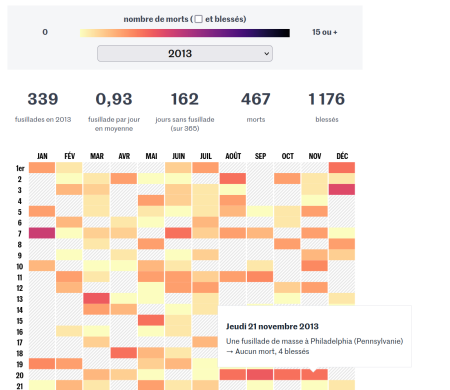Archive for beta distribution
max spacing between mass shootings [data graphics]
Posted in Books, R, Statistics with tags beta distribution, data analysis, data graphics, data journalism, Le Monde, Maine, mass shooting, maximum spacing, US politics, USA on January 11, 2024 by xi'ansimulating the maximum of Rayleigh variates
Posted in Books, Statistics, University life with tags beta distribution, chi distribution, John Strutt, Lord Raleigh, Nobel Prize, order statistics, random simulation, Rayleigh distribution on December 26, 2023 by xi'an An X validated question on an efficient way to simulate the largest order statistics of a Rayleigh (large) sample. Named after the 1904 Nobel recipient, John Strutt. This is not a commonly used distribution in statistics, since it coincides with the χ2 distribution. Anyway, thanks to its compact, closed form cdf, the largest order statistics can be directly simulated, at a constant cost in the sample size, as
An X validated question on an efficient way to simulate the largest order statistics of a Rayleigh (large) sample. Named after the 1904 Nobel recipient, John Strutt. This is not a commonly used distribution in statistics, since it coincides with the χ2 distribution. Anyway, thanks to its compact, closed form cdf, the largest order statistics can be directly simulated, at a constant cost in the sample size, as
or equivalently as
since the smallest order statistic from a Uniform sample, U(1), is distributed from a Be(1,N) distribution.
where is .5?
Posted in Statistics with tags beta distribution, mathematical puzzle, order statistics, R, The Riddler on September 10, 2020 by xi'anA Riddler’s riddle on breaking the unit interval into 4 random bits (by which I understand picking 3 Uniform realisations and ordering them) and finding the length of the bit containing ½ (sparing you the chore of converting inches and feet into decimals). The result can be found by direct integration since the ordered Uniform variates are Beta’s, and so are their consecutive differences, leading to an average length of 15/32. Or by raw R simulation:
simz=t(apply(matrix(runif(3*1e5),ncol=3),1,sort)) mean((simz[,1]>.5)*simz[,1]+ (simz[,1]<.5)*(simz[,2]>.5)*(simz[,2]-simz[,1])+ (simz[,2]<.5)*(simz[,3]>.5)*(simz[,3]-simz[,2])+ (simz[,3]<.5)*(1-simz[,3]))
Which can be reproduced for other values than ½, showing that ½ is the value leading to the largest expected length. I wonder if there is a faster way to reach this nice 15/32.
easy Riddler
Posted in Kids, R with tags beta distribution, mathematical puzzle, order statistics, The Riddler on May 10, 2019 by xi'an The riddle of the week is rather standard probability calculus
The riddle of the week is rather standard probability calculus
If N points are generated at random places on the perimeter of a circle, what is the probability that you can pick a diameter such that all of those points are on only one side of the newly halved circle?
Since it is equivalent to finding the range of N Uniform variates less than ½. And since the range of N Uniform variates is distributed as a Be(N-1,2) random variate. The resulting probability, which happens to be exactly , is decreasing exponentially, as shown below…

Example 7.3: what a mess!
Posted in Books, Kids, R, Statistics, University life with tags beta distribution, cross validated, George Casella, Gibbs sampling, Introducing Monte Carlo Methods with R, Metropolis-Hastings algorithm, typos on November 13, 2016 by xi'an A rather obscure question on Metropolis-Hastings algorithms on X Validated ended up being about our first illustration in Introducing Monte Carlo methods with R. And exposing some inconsistencies in the following example… Example 7.2 is based on a [toy] joint Beta x Binomial target, which leads to a basic Gibbs sampler. We thought this was straightforward, but it may confuse readers who think of using Gibbs sampling for posterior simulation as, in this case, there is neither observation nor posterior, but simply a (joint) target in (x,θ).
A rather obscure question on Metropolis-Hastings algorithms on X Validated ended up being about our first illustration in Introducing Monte Carlo methods with R. And exposing some inconsistencies in the following example… Example 7.2 is based on a [toy] joint Beta x Binomial target, which leads to a basic Gibbs sampler. We thought this was straightforward, but it may confuse readers who think of using Gibbs sampling for posterior simulation as, in this case, there is neither observation nor posterior, but simply a (joint) target in (x,θ).
 And then it indeed came out that we had incorrectly written Example 7.3 on the [toy] Normal posterior, using at times a Normal mean prior with a [prior] variance scaled by the sampling variance and at times a Normal mean prior with a [prior] variance unscaled by the sampling variance. I am rather amazed that this did not show up earlier. Although there were already typos listed about that example.
And then it indeed came out that we had incorrectly written Example 7.3 on the [toy] Normal posterior, using at times a Normal mean prior with a [prior] variance scaled by the sampling variance and at times a Normal mean prior with a [prior] variance unscaled by the sampling variance. I am rather amazed that this did not show up earlier. Although there were already typos listed about that example.
